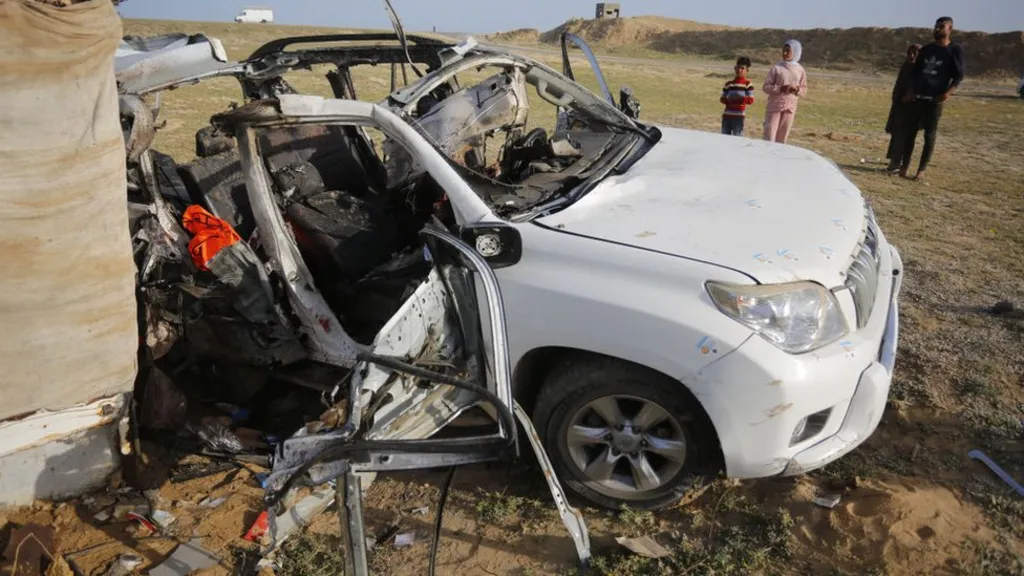Israel-Gaza: Inside IDF’s detailed briefing on aid convoy attack

Late on Thursday night, the Israel Defense Forces (IDF) convened a meeting for a group of international journalists at the defence ministry building in Tel Aviv. The IDF then set out for us the results of their initial inquiry into the killing of seven aid workers in Gaza.
Retired Maj Gen Yoav Har-Even described how the IDF’s drone operators mistook an aid worker carrying a bag for a gunman, and then targeted one of the World Central Kitchen vehicles with a missile.
The IDF then described how two people escaped that vehicle and got into a second car, which was hit by another missile from a drone.
The military confirmed that there were survivors from the second explosion, who managed to get into the third vehicle – which was then also hit by a missile.
By the end, all the aid workers were dead.
The IDF’s investigation concluded that the army unit involved had believed the vehicles they were tracking from the sky had been taken over by Hamas gunmen, and that they were not aware of the coordination procedures put in place between the military and World Central Kitchen for that evening.
It also said they also did not know the cars belonged to the charity, and the three air strikes were in violation of the army’s own procedures.
 Getty Images
Getty ImagesThe evidence from the investigation has been passed to the Military Advocate General – the Israeli army’s top legal authority – to determine if there has been any criminal conduct.
In addition, the army has sacked the major in charge of fire support. The brigade’s chief of staff, a colonel, has also been sacked. The divisional commander, brigade commander and the general in charge of the IDF’s Southern Command have been formally reprimanded.
The IDF sought to explain the context leading up to the fatal events of that evening.
The aid workers had been overseeing the distribution of food aid that had arrived on a ship from Cyprus and unloaded at a recently constructed jetty in the northern Gaza strip. Under coordination with the IDF, the World Central Kitchen team were transferring these supplies to a warehouse a few kilometres further south.
During this process, the IDF says their drone operators spotted a gunman riding on the roof of a large aid lorry that was being escorted by the WCK team. They played those of us at the briefing a somewhat blurry video – which has not been released to the public – showing a figure holding a gun, on top of the lorry. At one point the gun is fired, showing up clearly on the slowed-down black and white footage.
At this stage the military contacts World Central Kitchen but they are in turn unable to reach the team on the ground – where phone communication is patchy and aid agencies say they are prohibited by the IDF from using radios.
The drone footage also appears to confirm that at night, the stickers on the roof of the World Central Kitchen vehicles, with the charity’s logo, are not visible to the drone operator.
The military then tracks the convoy, including the aid lorry, to a warehouse. Then the convoy splits, with the aid lorry remains in the warehouse, and four SUV-type cars emerge. One of those vehicles heads north, and is then shown to contain gunmen, with weapons clearly visible from the drone footage, as they emerge next to another aid warehouse. The IDF say that these gunmen were not targeted, because of their proximity to an aid facility.
Meanwhile, three remaining vehicles belonging to World Central Kitchen begin to head south.
The drone team, the army says, now working under the assumption that they are dealing with Hamas militants and not an aid convoy, had misidentified one of the aid workers as a gunman, and claimed to have seen them enter one of the three WCK cars.
No footage of this moment was provided, but the military investigation concluded that it was a “misclassification… they saw that it’s a rifle but at the end of the day it was a bag”.
Under the mistaken belief that one vehicle now contained a gunman, authorisation to fire a missile is sought, and granted by superior officers. At 23:09 the first vehicle is struck, two minutes later the second, and at 23:13 the third final, fatal strike is launched.
The military’s conclusions are that three major failings occurred:
- The first is that the coordination plan agreed between the WCK and the IDF was not distributed down to operational level
- The second is that a suspicion that an armed man had entered one of the vehicles, was not enough to justify identifying it as a target
- The third failing was to continue firing after the first missile had struck the first car






